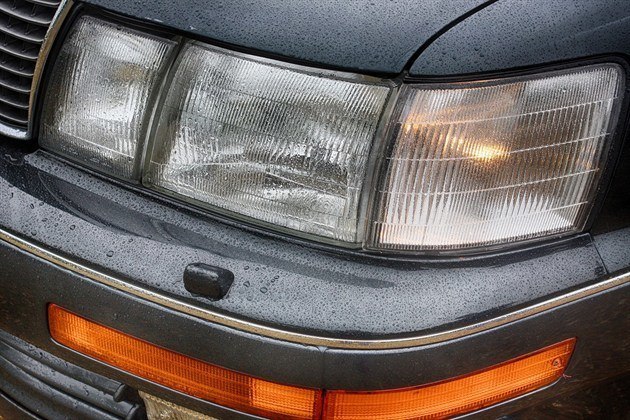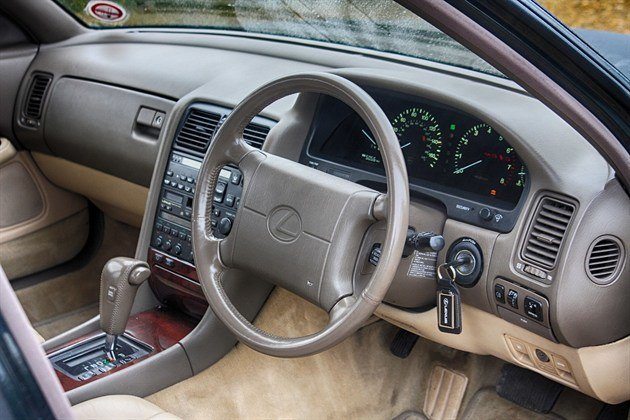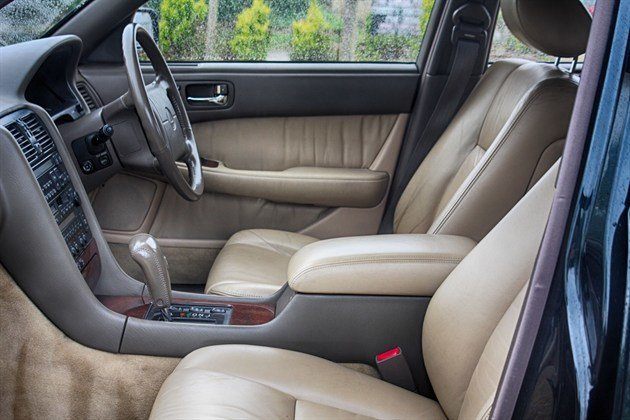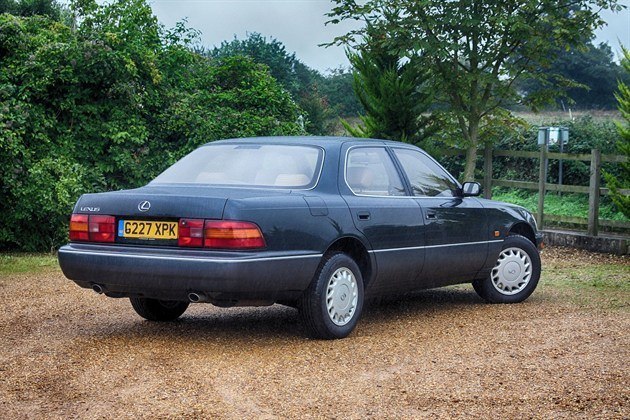- Reviews
- Best Classic Cars
- Ask HJ
- How Many Survived
- Classic Cars For Sale
- Insurance
- Profile
- Log out
- Log in
- New account
Lexus LS400 (1989 – 1994) Review
Lexus LS400 (1989 – 1994) At A Glance



The Lexus LS400 represented a huge leap into the unknown for parent company, Toyota. It was a luxury four-door saloon, built with the sole intention of beating automotive blue-bloods from Mercedes-Benz and Jaguar at their own game. It was also Japan's most convincing attempt yet at a national flagship, too, powered by a 4.0-litre quad-cam V8 that soon earned a reputation for being the smoothest engine in the industry. But where the LS400 really scored was in its all-round excellence, and lack of fussy Japanese detailing that marred so many upmarket products from the country before the new Lexus.
So, yes, it was packed with features, and had some pretty cutting-edge options, too, such as air suspension, but the overall design and look of the car was deliberately low-key in order not to frighten off S-Class or XJ6 customers. Of course, cracking the European luxury car market was not the work of a moment, and the LS400 initially failed to make great sales inroads in the UK market - but in the USA, where customers are equally demanding but less status conscious, it was an instant out-of-the box hit. Lexus stuck to its guns with the LS400, it was facelifted in 1992, and replaced in 1994 by an all-new car that looked pretty much the same. Strong points are other-worldly refinement, cool instruments, cossetting ride, excellent reliability and build quality - and that's why so many are still in daily, despite typically V8 fuel consumption...
Model History
- January 1983: Toyota's board decides to build a new luxury flagship
- January 1986: Lexus plans begin to take shape
- January 1989: Lexus LS400 launched at the Detroit Motor Show
- June 1992: Lexus LS400 facelifted
- September 1994: First generation LS400 replaced by a visually similar model - with the same name
January 1983
Toyota's board decides to build a new luxury flagship
 The Lexus story begins here. In 1983, Toyota's board led by Eiji Toyoda decided to build a luxury saloon designed specifically for export markets. The car was initially known as the F1 project (for 'Flagship-1), and it was conceived to beat the best from Mercedes-Benz and Jaguar.
The Lexus story begins here. In 1983, Toyota's board led by Eiji Toyoda decided to build a luxury saloon designed specifically for export markets. The car was initially known as the F1 project (for 'Flagship-1), and it was conceived to beat the best from Mercedes-Benz and Jaguar.
It was effectively a money-no-object exercise, with huge resources (3900 personnel on the programme, with 450 prototype cars made), and would be unique within the Toyota model range, for having no carry-over parts from any other models.
January 1986
Lexus plans begin to take shape
By 1986, Kunihiro Uchida's styling was taking shape, and Lexus marque was created to sell the F1. Concurrently, one of the industry's most extensive customer clinic programmes was instigated – with every aspect of the car's design coming under the scrutiny of potential customers. Of Uchida's proposals, it was a relatively conservative three-box saloon that won out, despite being up against some very progressive proposals. The body-shape was signed off in May 1987, and months later, the Lexus LS400 had made its debut at the 1989 Detroit motor show.
January 1989
Lexus LS400 launched at the Detroit Motor Show

It took time for journalists and buyers to appreciate the scale of the achievement that the Toyota engineers had achieved with the Lexus LS400 (or Toyota Celsior on those markets that didn't sell Lexus – most notably Japan). Those conservative looks hid a brilliant technical package under a bushel; and it wasn't until the first drives in May '89 that it became clear that Toyota had created a car capable of fighting the world's best – just as Eiji Toyoda had wished, six years previously.
The LS400 bristled with innovations. But the technology was deployed in a way as not to scare more traditional buyers – a good example of this were the back-lit electroluminescent instruments, which were projected into the dashboard display. Ultra-modern in execution, despite looking like conventional analogue dials. Other novelties for 1989 included automatic tilt-and-telescoping steering wheel, powered seatbelt height adjustment, and a self-dimming rear-view mirror.
Inside, its switchgear was beautifully-engineered for quality of operation and tactile feedback, and the new 32-valve engine set new standards for refinement and power (sending a certain British rival back to the drawing board in the process). But the quality engineering went further – it was claimed there were 300 NVH-reducing features, with everything from insulating pads for the most banal of fittings, to vibration-damped grab-handles. And all of this detail engineering laid-out Lexus' stall for years to come – as the definitive luxury car choice for those looking for the ultimate in quality, refinement and reliability.
June 1992
Lexus LS400 facelifted

The LS400 remained in production for three years before it was updated with the lightest of facelifts in 1992, before running until 1994 – when it was replaced by a car that it would take an expert to spot the differences...
September 1994
First generation LS400 replaced by a visually similar model - with the same name
Driving Lexus LS400 (1989 – 1994)
The Lexus LS400 represented nothing less than a revolution for the Japanese car industry. It was Toyota's money-no-object assault on the most difficult of automotive sectors - the luxury car market.
The car bristled with technology and had all the gadgets, space and pace you could ever need at the beginning of the 1990s. But has the LS400 stood the test of time, and does it stack up on today's roads?
Classic road test: Lexus LS400

In 1989, the Japanese motor industry truly had the world at its feet. For 12 fertile and memorable months, the Land of The Rising Sun reinvented itself, bloodied the noses of the European manufacturers like no other, and established its own true identity is a carmaking country. To that point, it could be argued that Japanese manufacturers were conservative, and not averse to a little plaigiarism.
But right at the end of the '80s, all that changed. The supercar and sports car markets, once judged the preserve of the Europeans and the Americans were split apart by the Japanese. Almost simultaneously, the Honda NSX and the Mazda MX-5 exploded on to the scene and sent the Europeans scuttling back to the drawing board. And in it seemed that the Japanese had no fear - Toyota created Lexus, and Nissan invented Infiniti to do battle with the likes of Mercedes-Benz and Jaguar in the luxury sector.
The idea of a luxury Japanese saloon wasn't exactly new - by the 1990s the Toyota Crown was available with every conceivable option. But what set the Lexus LS400 apart from its forebears was that it was styled and equipped very much to Western tastes.
About the Lexus LS400

We broke a photographic rule here and left the key in. Had we removed it, the instruments would have disappeared
When the Lexus LS400 was first unveiled, it was a true culture shock to us Europeans. Here was a car that was designed from the outset - and with absolutely no budget constraints - to be the best luxury car of its type in the world. Toyota's engineering team, which numbered thousands, was tasked with producing the smoothest, most capable luxury car, and started with a clean sheet. A new quad-cam V8 engine, displacing 3969cc and developing 250bhp was developed, while the all-round double wishbone suspension was tuned for ride comfort, and low road noise.
All the latest technology was designed in from outset, but in the true spirit of conservatism, no fripperies were specified - and even the wonderful electroluminescent instruments were designed to look like conventional analogue dials. As for the body, it was aerodynamic (the Cd is 0.29), and admirably rigid in its structure, but it was far from progressive looking - but that was deliberate, because it should not look out of place alongside all of those Jaguar XJs and S-Class Mercedes-Benzes in the Golf Club car park. Again, Toyota attained those aims for the imposing looking LS400.
Back in 1990, the road testers weren't too complimentary about the chrome-laden grille of the Lexuss LS400. 'Despite Toyota's claims that it began with the idealist's blank sheet of paper, this is copybook styling, the text supplied by BMW, Mercedes-Benz and Jaguar. Until you get to the nose, that is, where resides the biggest hun of chrome to come Britain's way since the '58 Vauxhall Cresta,' said Richard Bremner in CAR magazine. Time has certainly softened the Lexus' frontage - and in 21st century Britain, it actually looks low key, and the epitome of taste compared with some of the luxury challengers to emerge during the 1990s and '00s.
Inside the Lexus, it's more of a success. Okay, there's less wood than you might find in a Jaguar or Mercedes-Benz, but the California walnut that's used in the centre console has deep lustrous veneer and looks fantastic. The plastics for the dashboard and other mouldings are nicely textured and coloured, and feel good to touch. As for the leather that swathes the seats, it's not particularly soft, but it's great quality and certainly feels hard-wearing. It's a nice place to sit and conduct your business, and you get the feeling it would rack up 400,000 miles without raising a sweat.
Perhaps that's why there's so many left today in daily service.
On the road

Quad-cam V8 is creamy smooth and punchy at high revs
Our Lexus has enjoyed a full life. Despite occupying pride of place in Toyota GB's heritage press fleet, our example, which starred at the 1989 Motorfair at Earls Court, has more than 150,000 miles on the clock, but it may as well have 15,000 given the condition it's in. The lack of remote central locking is one of the few giveaways of this car's age - along with the ICE, central to which is a top-end tape deck and boot-mounted CD-multi-changer. It still sounds good compared with contemporary set-ups.
Even at the legal limit, the driver won't need to raise their voice barely above a whisper to converse with rear seat passengers
It's an interesting experience starting up the LS400. You turn-on the ignition, and the once-black void ahead of you springs into life, as the instruments come to life. At the same time, the steering wheel whirrs silently towards you. Time then, to adjust the seats - everything from headrest height to the height of the base... to the seat belt anchorage are all electrically powered. Once settled, fire up the engine, and enjoy the near-silence of the creamy smooth idle.
Back in 1990 when the LS400 was launched, they had a party trick they showed they showed to the UK press - the Toyota minders opened the bonnet of a car and balanced a coin on the engine as it idled away. And, yes, they didn't topple over. The four-speed transmission is matched with the engine perfectly - and as 'D' is selected, and the throttle squeezed, the car eases forward without a trace of driveline vibration.
Once underway, the dominant sensation is one of suspension movement, as that V8 engine is almost silent no matter what the speed, while the almost lack of wind noise means the LS400 is utterly hushed. Even at the legal limit, the driver won't need to raise their voice barely above a whisper to converse with rear seat passengers. But keen drivers will love the engine - floor the throttle, and it picks up like a thoroughbred. Between 4000-6000rpm, it has a distinct, albeit very distant, V8 howl, which for those who can afford its thirst when driven like this, will keep coming back for more.
Performance is more than adequate for keeping up with the 21st century flow - 0-60mph comes up in around 8.0 seconds, and the maximum speed is 150mph. Because the engine is actually quite peaky, you do have to stoke the throttle to make it go fast - and if you feel the need to overtake, it's best to floor the throttle and hit the overdrive lock-out button on the transmission.
Our car had adjustable suspension fitted, so you can choose between Sport and Comfort. After playing with this feature once, we just left it in comfort, and enjoyed the sensation of driving a car that does a great impression of smothering all but the roughest of roads. In a straight line, the LS400 is imperiously comfortable, and it maintains this feeling of indomitability. As for cornering, yes, it does that - but really, isn't all that a little unseemly in a car like this?
In a word, yes. The Lexus LS400 isn't a car about about comfort and wafting. Stick to that and you'll get the most of out of the regally luxurious Japanese saloon.
The HJClassics Verdict

Interior is top drawer quality, and extremely well put together. It's much more stylish than previous Japanese luxury cars
The Lexus LS400 is a magificent car to travel in. It's comfortable in the front, roomy in the rear, has a cossetting ride and has one of the smoothest engine and gerbox combos ever built. If you're looking for something that will glide you from one end of the country effortlessly, then this car is for you. You can also depend on a Lexus - a car that's consistently one of the most reliable you can buy - and even when they get old, these cars will soldier on for interstellar mileages thanks to near unimpeachable quality.
The LS400 was a magnificent achievement in 1989, and even if it didn't revolutionise the luxury car market in the way that the MX-5 and NSX did in their respective sectors, it did establish Lexus as a force to be reckoned with. Today it's a conspicuous bargain, and you can buy an early example for less than £1000, if you fancy lording it over the rest of us.
But let's face it, the LS400 has faults, otherwise we'd all own them, especially considering how cheap they are to buy. It's a very large car, and you'll need a big garage to house it. And unless you drive it gently everywhere on the motorway, it has frightening thirst that, when coupled with its 18.7 gallon fuel tank, makes £100-plus fill-ups an alarmingly regular occurence. But that's part and parcel of living with a classic luxury car.
The big question is would we have one over a similarly-priced Jaguar XJ40 or a Mercedes-Benz S-Class? Rather like our 1990 counterpart buying these cars new, we might have to take a heart over head decision, and stick to European. No-one said that buying cars at this level is a rational decision.

Lexus LS400 (1989 – 1994) Buying Guide
Good
- At the time, the World's most refined V8. Effortless acceleration.
- 16' 5" long by 6' wide and from 1765kg.
- Brilliant, fully controllable, utterly obedient five-speed autobox from Oct '97 (four-speed before).
- Unobtrusive traction and stability control system.
- As luxurious, reliable and trouble-free as you'd expect of an S-Class competitor built by Toyota.
- Three-year, 100,000-mile warranty.
- Quentin Willson reckoned they were fantastic buys at over 100,000 miles. He had no trouble with them. (But that was more than 10 yers ago. They are old cars now.)
- Trade generally approves of quality levels, particularly trim and switchgear. Lexus servicing seems to be top notch. Pre-August 1992 cars can legally be 'de-catted' for better performance and economy (talk to BBR on +44 (0)1280 702389). 241bhp three-speed auto Jan '90-Oct '94; 260 bhp 4-speed auto Oct '94-Oct '97; 280 bhp 5-speed auto from Oct '97. S and T reg cars came first in 2001 Top Gear / JD Power Customer Satisfaction Survey. Joint 2nd top make in 2002 'Which?' reliability survey cars 2000 - 2002; top for cars 1997 - 1999.
- Fuel consumption amazingly good. Easy 30 mpg on the motorway and 23-24 round town.
- Tyres not stupidly expensive – around £100 per corner for the correct Dunlops.
Bad
- Lack of steering 'feel' (even the Cadillac Seville STS is better in this respect).
- Pre-1995 model-year cars could suffer from engine surging. Limo 'stretchers' not happy about the thickness of the body panels.
- Lacquer coating on alloy wheels peels off, allowing them to oxidise badly.
- A new set of tyres and a complete exhaust system costs the wrong side of £2,500. Better to have a stainless steel system made up as long as the existing cat converters are still okay.
- Slightly above average warranty repair costs in 2003 Warranty Direct Reliability index (index 107.78 v/s lowest 31.93)due to high cost of individual repairs. Average warranty repair costs in 2003 Warranty Direct Reliability index (index 101.16 v/s lowest 31.93). Link:- www.reliabilityindex.co.uk
Watch
- Underservicing. Some busy company directors ran these cars very hard as mobile offices, clock up 75,000 miles a year, didn't always have time to get services done on time.
- Check 'cats' (£610 each).
- Buy younger with high mileage rather than old with low mileage.
- Toyota GB says: make sure the car has a full Lexus service history, that the automatic transmission fluid and filter have been changed every year, that the shocks and suspension are okay, that the timing belts have been changed at 60,000-mile intervals and that there is no excess wear on the rear discs through misuse of the parking brake. Check the exhaust system carefully (see above).
- Typical faults/suggestions on an 11 year old LS400:
- Alloy wheels corrode on all LS400s, not just early ones.
- Exhausts very rarely needs replacing – if it does cheapest route is to get a stainless custom made for around £500.
- Most cars need suspension work around 100,000 miles – control arms and balljoints go in particular. This can be expensive.
- Steering wheel adjust motors can go and can be a pain to fix.
- Leather on trim and seats can wear more than one would expect, look for tears on driver’s seat bottom in particular
- Dot matrix display on dash loses pixels
Recall data
- Cars built 1992 - 1994, possible failure of suspension ball joint, affecting 1298 cars
- (Unknown date) possibility that the vehicle stability control (VSC), can operate wrongly when a call is being received on a mobile phone that is near the console box, if this should happen the brakes might activate without prior notice.

.JPG?width=640&height=426&rmode=crop)
.JPG?width=640&height=426&rmode=crop)
.JPG?width=640&height=426&rmode=crop)
.JPG?width=640&height=426&rmode=crop)
.JPG?width=640&height=426&rmode=crop)
.JPG?width=640&height=426&rmode=crop)
.JPG?width=640&height=426&rmode=crop)
.JPG?width=640&height=426&rmode=crop)
.JPG?width=640&height=426&rmode=crop)
.JPG?width=640&height=426&rmode=crop)
.JPG?width=640&height=426&rmode=crop)